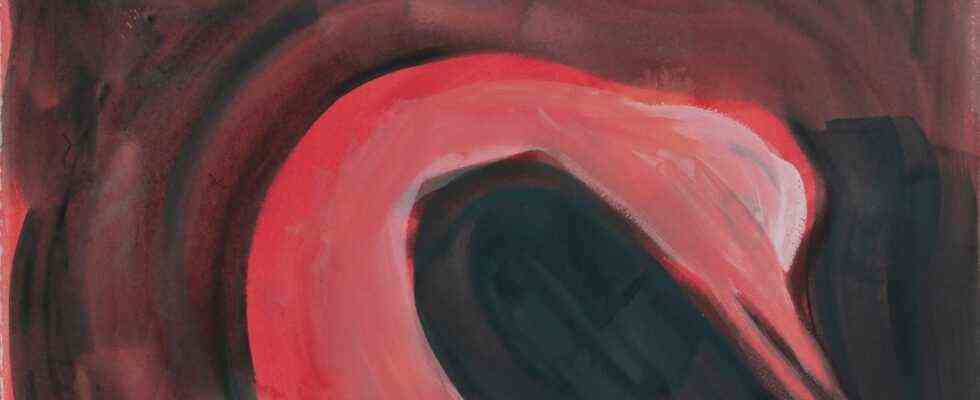Addressing motherhood in art is not gifted with many examples. There is the old tradition of painting Mary with little Jesus. But this relationship, stylized by men, has as much credibility from the experiential perspective as the immaculate conception. Otherwise, what is perhaps the most important phase in childhood development, and perhaps the most strenuous in a woman’s life, is hardly reflected in art. Little has changed in that respect since women produce an ever larger proportion of the art that has been noticed. Is the birth, breastfeeding, and care of an infant so boring, private, and ordinary that artists have to ignore them as a fruitless time?
The paintings, dominated by the color of blood, show in an aggressive manner the phases of an ancient tragedy
In her first major solo exhibition in Germany at the Kestner Society in Hanover, Camille Henrot collected dozens of pictures on the subject. During the first lockdown that the French star artist experienced in her adopted home New York, she painted impressive series of small-format pictures on the subject, but these are hardly suitable for the birth preparation course. The paintings, dominated by the color of blood, show in an aggressive manner the phases of an ancient tragedy. Sucking and devouring are similar to the point of confusion, babies with water heads and mothers with bird heads seem to be at constant war. Saturn, the child eater, sits in the bathtub with himself as an infant. Arms are like whips, genital organs are overwhelming.
Camille Henrot at work, what is created will be called “Mon Corps de Femme”.
(Photo: Courtesy of the artist, Josep Fonti / VG Bild Kunst, Bonn 2021)
“War and birth have a lot in common in their intensity,” explains Henrot: “Fear for your own life, for the life of others, extreme physical pain, lack of sleep, helplessness and the difficulty of sharing these experiences together.” The topic of “birth” is still dominated by transfiguring kitsch and scientific objectivity, so that Henrot feels that the true circumstances of the act of giving life are “taboo”. Which is why she prefers to show her truth about pain, fear and the struggle for survival instead of clichés about “motherly happiness” and blissful babies.
A bad-tempered, large-breasted Moses sits uncomfortably with his bare bottom on an Egyptian pyramid
This provocative attack on the masculine ideology of holy motherhood is in the exhibition entitled “Mother Tongue” in the context of other works that address religious rites and images. A large hall with seven frescoes in the style of naive Bible illustrations celebrates mockery of Christian models. A bad-tempered, big-breasted Moses sits uncomfortably with his bare bottom on an Egyptian pyramid, the “shepherd” with the holy sheep smokes a joint bored, and the hermit in the desert is sodomized by a large rabbit. A little less blasphemous is the 3D video work “Saturday”, in which Adventist baptism rituals are associated with marine pollution, surfing, tropical storms, whales, crabs and other images that tell of the universal importance of water in times of a global environmental crisis.
Camille Henrot: “What She Says” (2020)
(Photo: Courtesy of the artist and Kamel Mennour / VG Bild Kunst, Bonn 2021)
Here associations between belief, science and communication are made rather subtly, in the spirit of Camille Henrot’s most famous work “Grosse Fatigue”, for which she composed a kind of Warburg’s picture atlas from Internet images for the 2013 Venice Art Biennale. In a tough ride through cultural history, she linked creation myths from different religions and cultures, for which she won the Silver Lion.
One phallus goes for a walk, another turns into a long bosom
This drive for variation is particularly pronounced in her elaborate metal sculptures, which are absurd reinterpretations of abstract post-war art. Some look like metal thieves were caught stealing a Henry Moore sculpture, because dirty grinding wheels are part of the plastic. One phallus goes for a walk, another turns into a long bosom. Violence and sex are the underground to striking metaphors with which Camille Henrot brings the smooth sculpture without content, as it stood in front of chancellor bungalows and corporate headquarters, back into concrete social life.
Despite the switch between the media, with which Camille Henrot has impressed the art world for around ten years, her artistic mother tongue – the critical reflection of ideologies – remains a unifying element. The impulse for this brooding in pictures is formulated at the end of the exhibition as the last sentence of a poem: “Time for change”.
Mother tongue. Kestnergesellschaft, Hanover. Until August 8th.

